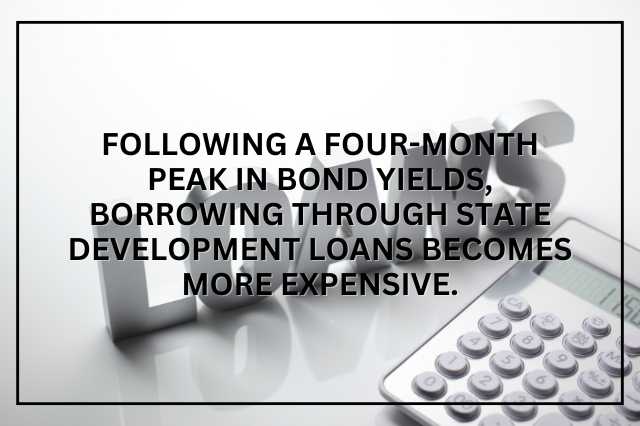
loading...

Following a four-month peak in bond yields, borrowing through state development loans becomes more expensive.
After the yield on government securities increased to a four-month high, the cost of borrowing for state governments through the state development loans (SDL), which were generated to support their budget deficit, increased dramatically to 17 basis points (bps) at the most recent weekly auction. The Reserve Bank of India (RBI) reported that during an auction on August 5, the cut-off yield on the 10-year SDL for Goa was set at 7.17 percent, while for Tamil Nadu it was slightly lower at 7.09 percent, but significantly higher than the SDLs of Bihar and Meghalaya, which were 7.02 percent and 7 percent, respectively. Concerns that the proposed reform of the goods and services tax (GST) regime will likely result in lower revenue and more government borrowing will cause the yield on benchmark sovereign bonds to jump to a four-month high on August 19. In his 79th Independence Day speech, Prime Minister Modi pledged to implement GST reforms for the future. According to statistics from the Clearing Corporation of India (CCIL), the yield on the 10-year benchmark bond is close to 6.5217 percent on August 19. According to the Finance Ministry, the Center has essentially suggested moving toward a simpler tax system with two slabs: standard and merit, with special rates applied to a limited number of commodities. According to experts, this has sparked worries about decreased revenue and could lead the Center to take out more loans from the market through government securities. The spike in government bond yields to a four-month high has significantly raised borrowing costs for state governments, making State Development Loans (SDLs) more expensive. At the latest auction, the cut-off yield for Goa’s 10-year SDL touched 7.17 percent, while Tamil Nadu’s stood at 7.09 percent, both notably higher than Bihar and Meghalaya, which were around 7 percent. This rise of nearly 17 basis points indicates growing market caution around fiscal risks. A key factor driving this surge is the anticipation of reforms in the Goods and Services Tax (GST) system. The Centre has proposed simplifying the structure into two slabs — standard and merit — with special rates only for a few commodities. While this may enhance efficiency in the long run, it has raised concerns of short-term revenue loss, prompting expectations that both the Centre and states may have to borrow more aggressively to bridge fiscal gaps. On August 19, the benchmark 10-year government bond yield climbed to 6.52 percent, reflecting these concerns. The higher yields have a direct impact on SDL pricing since state borrowing costs move in tandem with sovereign bond trends. For states, this means an additional interest burden at a time when fiscal pressures are already mounting due to rising expenditure needs. Economists warn that if yields remain elevated, states could face a vicious cycle of higher borrowing costs and larger fiscal deficits. While GST reforms are aimed at creating a simpler tax system, the near-term fiscal strain could weigh heavily on states’ ability to fund development projects and maintain financial stability.
Just Login and Customize
Our Features Easily.
USERNAME : [email protected]
PASSWORD : admin1234